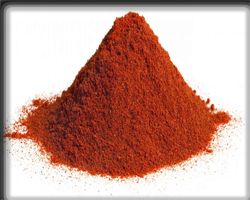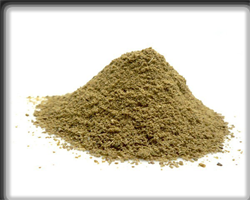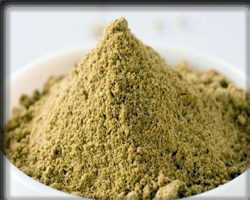 Turmeric powder is a bright yellow powder made by dry
grinding of mature turmeric rhizomes (underground
stems). The use of turmeric for coloring and flavoring
food, for cosmetic purposes and for medicinal
properties dates back to the ancient Vedic culture of
India. Used in almost all Indian curries, this spice
has almost no calories (1 tablespoon = 24 calories)
and zero cholesterol. It is rich in dietary fiber,
iron, potassium, magnesium and vitamin B6.
Turmeric powder is a bright yellow powder made by dry
grinding of mature turmeric rhizomes (underground
stems). The use of turmeric for coloring and flavoring
food, for cosmetic purposes and for medicinal
properties dates back to the ancient Vedic culture of
India. Used in almost all Indian curries, this spice
has almost no calories (1 tablespoon = 24 calories)
and zero cholesterol. It is rich in dietary fiber,
iron, potassium, magnesium and vitamin B6.
Turmeric, The primary rhizomes, round in shape are
called 'bulbs', while the thin, long secondary
rhizomes are 'fingers'. It has a characterized
fragrance, peppery aroma & it’s slightly bitter in
taste with a musky flavor.
Origin and Distribution
It is a native of India. Apart from India, it is cultivated in Pakistan, Malaysia, Myanmar, Vietnam, Thailand, Philippines, Japan, Korea, China, Sri Lanka, Nepal, East & West Africa, South Pacific Islands, Malagasy, Caribbean Islands and Central America. In India, it is cultivated in the States of Andhra Pradesh, Maharashtra, Orissa, Tamil Nadu, Karnataka and Kerala.
Uses:
- In India, turmeric is used in almost all curries and
gravy dishes. It gives a rich color and a unique
flavor to the food.
- Turmeric is a well-known preservative. Scientists
from Gujarat found that adding turmeric to paneer
(cottage cheese) extends the shelf life of paneer up
to 12 days.
- Turmeric is a great pesticide. Sprinkle turmeric
(powder) water near all the entry points of your house
to ward of insects, ants, and termites.
Botanical name |
Family name |
Commercial part |
Curcuma longa L. |
Zingiberaceae |
Rhizome or underground stem |
|


 Chili powder is a widely used spice in various soups, stews, and -- of course -- chilis. It can also be used as a component of marinades or dry rubs for meats as well as incorporated into burgers. Chili powder is actually a fairly healthy seasoning, with significant amounts of several beneficial nutrients.
Chili powder is a widely used spice in various soups, stews, and -- of course -- chilis. It can also be used as a component of marinades or dry rubs for meats as well as incorporated into burgers. Chili powder is actually a fairly healthy seasoning, with significant amounts of several beneficial nutrients. Cumin is available both in its whole seed form and ground into a powder.
Cumin is available both in its whole seed form and ground into a powder. According to Bright Fame powdered coriander is good for digestion. It also increases appetite. It helps in purifying the blood and curing inflammation, fever and as well as various allergies. Due to 'cooling' qualities of coriander, this spice is considered to be very beneficial for restoring the 'Pitta' balance.
Due to 'strong' qualities of this wonderful spice, it is always advisable to consume it on the advise of a qualified practitioner of Ayurvedic medicine.
According to Bright Fame powdered coriander is good for digestion. It also increases appetite. It helps in purifying the blood and curing inflammation, fever and as well as various allergies. Due to 'cooling' qualities of coriander, this spice is considered to be very beneficial for restoring the 'Pitta' balance.
Due to 'strong' qualities of this wonderful spice, it is always advisable to consume it on the advise of a qualified practitioner of Ayurvedic medicine.
 Fenugreek or methi is a popular spice having a strong scent and a pungent flavor. Though it is mostly used for culinary purposes, it has a number of medicinal and beauty benefits too.Fenugreek powder is the dust form of the spice and is easily available in the market. You can also prepare it in your home by grinding dried fenugreek seeds thoroughly.
Fenugreek or methi is a popular spice having a strong scent and a pungent flavor. Though it is mostly used for culinary purposes, it has a number of medicinal and beauty benefits too.Fenugreek powder is the dust form of the spice and is easily available in the market. You can also prepare it in your home by grinding dried fenugreek seeds thoroughly. Turmeric powder is a bright yellow powder made by dry
grinding of mature turmeric rhizomes (underground
stems). The use of turmeric for coloring and flavoring
food, for cosmetic purposes and for medicinal
properties dates back to the ancient Vedic culture of
India. Used in almost all Indian curries, this spice
has almost no calories (1 tablespoon = 24 calories)
and zero cholesterol. It is rich in dietary fiber,
iron, potassium, magnesium and vitamin B6.
Turmeric powder is a bright yellow powder made by dry
grinding of mature turmeric rhizomes (underground
stems). The use of turmeric for coloring and flavoring
food, for cosmetic purposes and for medicinal
properties dates back to the ancient Vedic culture of
India. Used in almost all Indian curries, this spice
has almost no calories (1 tablespoon = 24 calories)
and zero cholesterol. It is rich in dietary fiber,
iron, potassium, magnesium and vitamin B6.